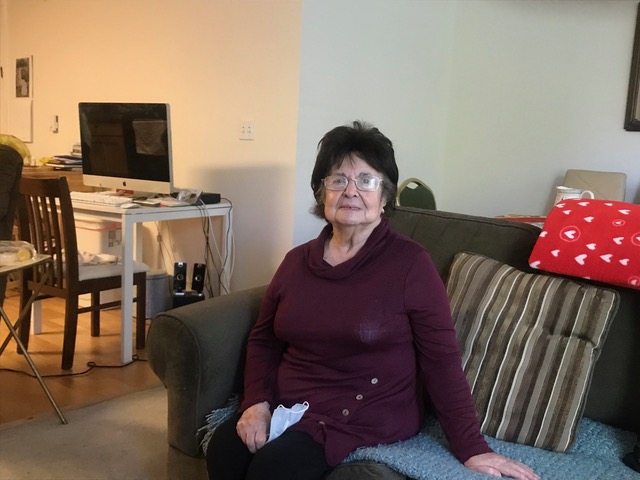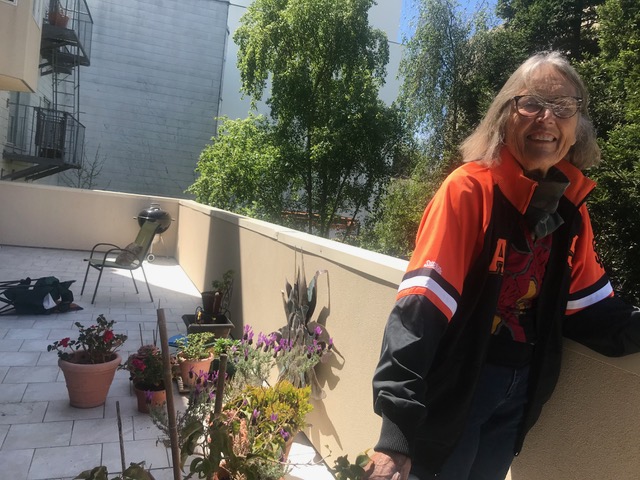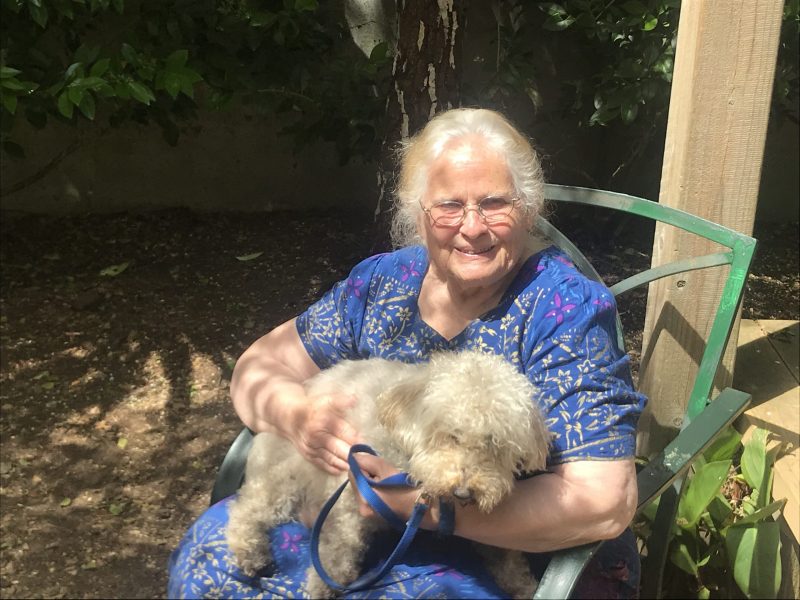Coping with Covid-19: Perspective, resilience and optimism buoys seniors’ apartment building
It takes a lot to scare 90-year-old Esther Goldberg. She survived the Holocaust, hiding for years from the Nazis who occupied Brussels. Martin Pennisi, 82, has a high threshold for fear as well. He spent more than a decade in a combat zone during the Vietnam War – with shrapnel scars to prove it.
And 86-year-old Nancy Stevens knows a thing or two about anxiety: She’s been battling multiple forms of cancer for years.
In this time of pandemic, when seniors are known to be the most vulnerable segment of the population, you might expect the next line of this story to be something like: “But the coronavirus terrifies them, and they’ve huddled in their lonely apartments for two months.”
But that’s not the case. Goldberg, Pennisi and Stevens are three of the 20 or so tenants of a senior-focused apartment building in San Francisco’s Richmond District. They worry and take precautions, of course, but they defy the stereotype of the weak and terrified senior waiting out the epidemic. And so do a surprising number of their neighbors.
Experience begets optimism
Interviews with about a third of the tenants reveal a resilience and optimism earned from, well, lengthy lives and sometimes difficult experience. Most are in their 70s and 80s. They keep their minds and bodies active, use digital technology, and maintain a certain perspective and healthy optimism.
“After the dire situations I’ve been through, this doesn’t scare me,” said Pennisi, a retired investor and wine merchant who served in Vietnam as a civilian employee. His back and arms are scarred from the explosion of a hand grenade, injuries that make extended walking difficult. “I know I can get through this.”

“I don’t live in fear for myself but for my children,” said Goldberg, a grandmother of seven. Born in Belgium, Goldberg was a teenager when the Nazis occupied her country. Her family was Jewish, and when efforts to leave the country came too late, her father convinced a gentile business associate to shelter her. She passed as Christian during the war, but her family was sent to Auschwitz and didn’t survive.
The former secretary – she once worked for the European Union — gets up early, does some cooking, and talks to her son twice a day. What’s missing? Shopping trips with her daughter, seeing the grandkids – and hugs.
Despite her resilience, Goldberg said the quarantine brings back frightening memories of her time hiding from the Nazis. “We were all so scared,” she recalled. “I was hidden in my own neighborhood. I couldn’t see anyone, not even my parents.”
Being unafraid isn’t the same as being in denial. Residents wear masks when others are around and avoid crowding into the building’s elevator. Many forego shopping, relying instead on delivery services and the help of younger family members.
But quarantine life can be lonely.

Because her health is frail, Stevens rarely leaves her apartment. She misses her daily excursion to a nearby café for breakfast and conversation with friends. Her daughter and grandson come by with groceries, but she doesn’t see them nearly as often as she did. “I miss them. I miss hugs.”
But she refuses to feel sorry for herself, and spends time reading, exercising on a recumbent bike, and doing a bit of work on the container garden that brightens her terrace. Is she frightened? “At this point, I’m accepting. We’ll all go at some point, but I’m still fighting.”
Missing family and close friends is a recurring theme. Most of the residents in the five-story building – it’s owned by the nearby Russian Orthodox cathedral on Geary Boulevard – live alone. Before the lockdown began in March, many went to senior centers, traveled a bit, attended plays and concerts, and entertained friends and relatives.
Little of that happens now. But like the rest of San Francisco, people find other ways to be productive and happy. Paul Uhov continues to volunteer as a business consultant. “I don’t go the office, but I check in over the phone.”
Faith fends off fear for some
Uhov misses the morning services at the cathedral, but the church has streamed Easter services and Sunday morning worship. His strong faith, he said, keeps him from being afraid. “It’s the will of God. Maybe the pandemic has been sent to teach us a lesson.”

Meg Gorman, a substitute teacher, isn’t happy about the loss of income, but she is tutoring a few students, cooking a lot and taking long walks with her dog in Golden Gate Park and Land’s End. “Actually, I feel just splendid,” she said.
The building and its residents aren’t altogether typical for San Francisco. It’s reserved for people 55 and older. Although rents are well below market rates, the spacious apartments aren’t cheap, and the residents, many of whom speak Russian, are largely white and middle class.
Goldberg said she feels fortunate to be leading a relatively comfortable life, but she worries that “so many people with little money are going through this. I’m scared for them.”
A chance for greater appreciation
For those who live with a partner or spouse, spending so much time together can be challenging. “I get out a bit to have some personal space,” said Pennisi. But watching his wife paint and draw has given him a greater appreciation of her artistic ability. “I didn’t know she was this good,” he said.
Their building is wired for cable and internet connections, and while it’s easy to assume that the elderly are technology challenged, Gorman and her neighbors stay in touch with family and friends using a variety of digital devices. Email, Face Time and now Zoom are lifelines, along with the ubiquitous smartphone and fast internet connections.
“I use Zoom to stay in touch, and I play online games, like mahjong,” said Harriet Zisman, 78. Zisman has significant health problems, including severe asthma, and she knows that a bout of Covid-19 could be fatal. “At first I was terribly anxious. I was worried and scared and wondered if I should update my DNR (do not resuscitate) order.”
But the fear has receded. “I’m controlling it (the possibility of infection) as much as I can. While I’m here I need to enjoy life. If I go, I go.”





